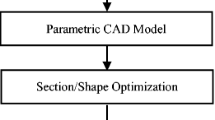Abstract
Locator layout is a key concern in checking fixture design (CFD) to hold a checked part accurately and stably. Since the localization accuracy evaluation only considered the positions and directions of locators, ignoring the whole layout of them which is related with localization stability, in this paper, a multi-objective continuous searching optimization and decision algorithm is proposed to obtain an accurate, stable, and detachable locator layout for CFD. The algorithm searches a trade-off between two goals, location accuracy and stability, and constrains the layout with the 3-2-1 location principle to assure the detachability. In order to remove the discretization error in traditional optimization methods, the algorithm searches locator points on the surfaces of the checked part model continuously instead of the discretized points. At last, the algorithm is realized and embedded in Siemens NX by application program interface and two case studies are presented to verify its feasibility and practicability.
Similar content being viewed by others
References
Asada H (1985) Kinematic analysis of workpart fixturing for flexible assembly with automatically reconfigurable fixtures. Robot Autom 1:86–94
Nee A Y C, Tao Z J, Kumar A S (2004) An advanced treatise on fixture design and planning. World Scientific, Singapore
Hu C-Q (2003) Study on checking fixture design and its application for auto-body covering panels. PhD Dissertation, Shanghai Jiaotong University
Asada H, Kitagawa M (1989) Kinematic analysis and planning for form closure grasps by robotic hands. Robot Comput Integr Manuf 5:293–299
Dizioğlu B, Lakshiminarayana K (1984) Mechanics of form closure. Acta Mechanica 52:107–118. doi:10.1007/BF01175968
Wang Y, Nagarkar SR (1999) Locator and sensor placement for automated coordinate checking fixtures. J Manuf Sci Eng Trans ASME 121:709–719
Wang MY (2002) Tolerance analysis for fixture layout design. Assem Autom 22:153–162. doi:10.1108/01445150210423198
Montana DJ (1988) The kinematics of contact and grasp. Int J Robot Res 7:17–32
Wang MY, Liu T, Pelinescu DM (2003) Fixture kinematic analysis based on the full contact model of rigid bodies. J Manuf Sci Eng Trans ASME 125:316–324. doi:10.1115/1.1557293
Kang Y, Rong Y, Yang JC (2003) Computer-aided fixture design verification. Part 2. Tolerance analysis. Int J Adv Manuf Technol 21:836–841
Qin GH, Zhang WH (2007) Modeling and analysis of workpiece stability based on the linear programming method. Int J Adv Manuf Technol 32:78–91. doi:10.1007/s00170-005-0315-3
Marin RA, Ferreira PM (2001) Kinematic analysis and synthesis of deterministic 3-2-1 locator schemes for machining fixtures. J Manuf Sci Eng 123:708–719
Nakamura Y, Nagai K, Yoshikawa T (1989) Dynamics and stability in coordination of multiple robotic mechanisms. Int J Robot Res 8:44–60
Li Z, Sastry SS (1988) Task-oriented optimal grasping by multifingered robot hands. Robot Autom 4:32–44
Xiong CH, Xiong YL (1998) Stability index and contact configuration planning for multifingered grasp. J Robot Syst 15:183–190
Jiang A, Fan Q, Zheng C, Yun K, Jin B (2010) Stability evaluation of fixture locating layout and research in locator searching algorithm. J Shanghai Jiaotong Univ 4:484–488
Wang MY (2000) An optimum design for 3-D fixture synthesis in a point set domain. IEEE Trans Robot Autom 16:839–846
Wang MY, Pelinescu DM (2001) Optimizing fixture layout in a point-set domain. IEEE Trans Robot Autom 17:312–323
Pelinescu DM, Wang MY (2002) Multi-objective optimal fixture layout design. Robot Comput Integ Manuf 18:365–372
Dan D, Xiang GL, Liu YH, Wang MY (2002) Fixture layout design for curved workpieces. IEEE Int Conf Robot Autom 1(4):2906–2911
Kim P, Ding Y (2004) Optimal design of fixture layout in multistation assembly processes. IEEE Trans Autom Sci Eng 1:133–145. doi:10.1109/TASE.2004.835570
Liu YH (2004) Optimal fixture layout design for 3-D workpieces. IEEE Int Conf Robot Autom 1–5:5274–5279
Lam Y, Ding D (2004) A complete and efficient algorithm for searching 3-D form-closure grasps in the discrete domain. IEEE Trans Robot 20:805–816
Zhu XY, Ding H (2007) An efficient algorithm for grasp synthesis and fixture layout design in discrete domain. IEEE Trans Robot Autom 23:157–163. doi:10.1109/TRO.2006.888919
Zheng Y, Chew CM (2009) Efficient procedures for form-closure grasp planning and fixture layout design. J Manuf Sci Eng Trans ASME 131. doi:10.1115/1.3159049
Zheng Y, Chew C (2010) A geometric approach to automated fixture layout design. Comput Aided Des 42:202–212
Cai W, Hu SJ, Yuan JX (1997) A variational method of robust fixture configuration design for 3-D workpieces. J Manuf Sci Eng 119:593–602
Deb K, Pratap A, Agarwal S, Meyarivan T (2002) A fast and elitist multiobjective genetic algorithm: NSGA-II. IEEE Trans Evol Comput 6:182–197. doi:10.1109/4235.996017
Huang BQ, Buckley B, Kechadi TM (2010) Multi-objective feature selection by using NSGA-II for customer churn prediction in telecommunications. Expert Syst Appl 37:3638–3646. doi:10.1016/j.eswa.2009.10.027
Hwang CL, Yoon K (1981) Multiple attribute decision making: methods and applications: a state-of-the-art survey. Springer, Berlin
Li X (2009) Study of multi-objective optimization and multi-attribute decision-making for economic and environmental power dispatch. Electr Power Syst Res 79:789–795. doi:10.1016/j.epsr.2008.10.016
Author information
Authors and Affiliations
Corresponding authors
Rights and permissions
About this article
Cite this article
Jiang, K., Zhou, X., Li, M. et al. A multi-objective optimization and decision algorithm for locator layout continuous searching in checking fixture design. Int J Adv Manuf Technol 67, 357–366 (2013). https://doi.org/10.1007/s00170-012-4489-1
Received:
Accepted:
Published:
Issue Date:
DOI: https://doi.org/10.1007/s00170-012-4489-1




